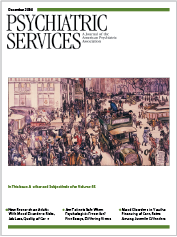Identifying Life Stressors of Patients With Schizophrenia at Hospital Discharge
To the Editor: The period after discharge from a psychiatric hospital represents a critical time in the course of illness for individuals with schizophrenia. The transition from the hospital to another setting has been found to be associated with increased levels of stress and, perhaps as a consequence, with exacerbation of psychiatric symptoms, noncompliance with medication, substance abuse, and suicide attempts (1,2). In particular, the link between discharge, stress, and suicide may be important, because 20 to 40 percent of suicides among persons with schizophrenia occur within three months of discharge (3), with the risk particularly high during the first five days after discharge.
Although most studies of stress and schizophrenia focus on major life events, it has been suggested that it is more the demands of everyday life that lead to stress (4) and that daily hassles are better predictors of subjective stress than major life events (5). Schizophrenia is characterized by repeated hospitalizations and discharges. Even though it is recognized that the days after discharge are a high-stress period, there is a lack of information about the stressors that individuals with schizophrenia experience during this period.
The aim of this study was to enumerate these stressors. We assessed 110 individuals with a DSM-IV diagnosis of schizophrenia within a week of their discharge from an inpatient unit at the New York State Psychiatric Institute. The study was approved by the institute's institutional review board, and written informed consent was obtained from all participants. Data were collected from 1999 to 2001. Stressors were assessed by an open-ended question asking participants to indicate the three most stressful issues they were facing at the time of discharge. The 110 participants provided 279 responses (a mean±SD of 2.54±1.06 responses per person; range, zero to five responses).
The most prevalent individual stressor was psychotic symptoms, identified by 34 participants (31 percent), followed by adjustment to future residential settings, identified by 31 (28 percent). Among categories of stressors, 47 participants (43 percent) endorsed one or more interpersonal stressors—loneliness and issues related to social activities, relationships with parents, and relationship with other relatives or significant others. Employment-related stressors—finding or maintaining employment—were the next most common, endorsed by 36 participants (33 percent), followed by stress related to concerns about general well-being or the possibility of future hospitalizations, which were endorsed by 34 participants (31 percent). Only five participants (4 percent) responded to our question by stating "I don't know" or "No stress."
Our findings suggest that persons with schizophrenia who are anticipating discharge experience at least one stressor. Stressors related to psychotic symptoms and interpersonal relations were frequently reported, as were stressors related to adjustment to future residential settings, general well-being, future hospitalizations, and employment. Although obtaining a job may be unrealistic for many individuals with schizophrenia, the stress associated with this issue may be present, and it reflects important predischarge concerns. Future research focused on linking subjective experiences of stress with more objective measures of stress will be important. We are using the results of our study to develop a tool for measuring stress at discharge. When stressors are identified at discharge, interventions to help individuals manage and cope with specific stressors can be incorporated into the discharge plan.
The authors are affiliated with the department of psychiatry at Columbia University and the department of medical genetics at New York State Psychiatric Institute in New York City.
1. Bergen J, Hunt G, Armitage P, et al: Six-month outcome following a relapse of schizophrenia. Australia and New Zealand Journal of Psychiatry 32:815–822, 1998Crossref, Medline, Google Scholar
2. Heila H, Isometsa ET, Henriksson MM, et al: Suicide and schizophrenia: a nationwide psychological autopsy study on age- and sex-specific clinical characteristics of 92 suicide victims with schizophrenia. American Journal of Psychiatry 154:1235–1242, 1997Link, Google Scholar
3. Harkavy-Friedman JM, Restifo K, Malaspina D, et al: Suicidal behavior in schizophrenia: characteristics of individuals who had and had not attempted suicide. American Journal of Psychiatry 156:1276–1278, 1999Abstract, Google Scholar
4. Beck JC, Worthen K: Precipitating stress, crisis theory, and hospitalization in schizophrenia and depression. Archives of General Psychiatry 26:123–129, 1972Crossref, Medline, Google Scholar
5. Norman RM, Malla AK: Subjective stress in schizophrenic patients. Social Psychiatry and Psychiatric Epidemiology 26:212–216, 1991Crossref, Medline, Google Scholar



